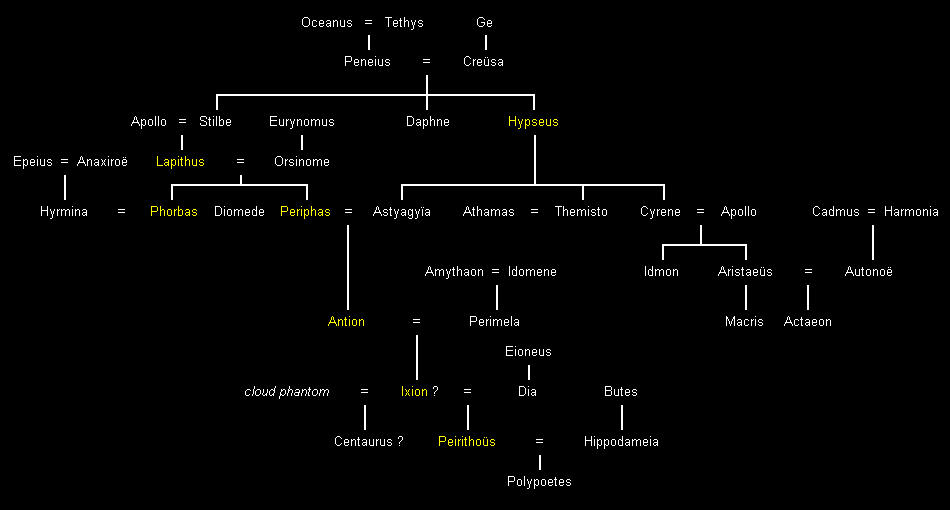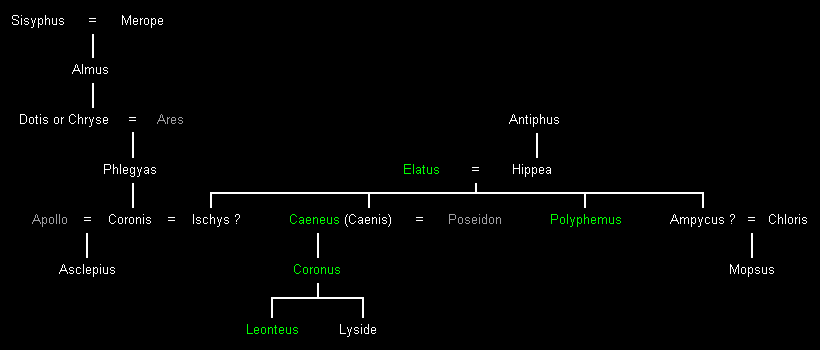Lapith House of Thessaly


The family tree shown above lists the royal family of the Lapiths in Thessaly. The Lapiths ruled around the valley of the Peneius River in Thessaly. This family were the descendants of the river god Peneius and his wife Creusa, a daughter of Ge (Gaea).
Peneius had a son (Hypseus) and a daughter (Stilbe), who would establish the royal house of the Lapiths. At first Hypseus ruled, but he was succeeded by his nephew Lapithus, the son of Apollo and his sister Stilbe. Lapithus was the eponym of the Lapiths. His two sons, Phorbas and Periphas, succeeded their father, but Phorbas later migrated to Elis. Periphas married his aunt, Astyagyïa, daughter of Hypseus.
Two Lapith kings became famous. One was Ixion, the son of Antion. He tried to rape the goddess Hera and was punished in Tartarus for this attempt.
His son Peirithoüs was the other famous king, mainly because Peirithoüs was the companion of Theseus. Peirithoüs may have possibly been the son of Zeus, instead of Ixion, if Zeus had seduced the Lapith's wife. His wedding was famous, because of the battle between the Lapiths and the Centaurs. Peirithoüs was a reckless king, and would later sit forever in the Seat of Forgetfulness, because he tried to abduct Persephone, the consort of the god Hades.
Polypoetes, Peirithoüs' son, fought beside Leonteus, son of Coronus, during the Trojan War.
As to the family tree below, it shows a different Lapith family, but this family was just as famous as the royal family, because many Lapith heroes came from this line.
The Lapith chieftain Elatus was the father of several heroes, such as the girl turned into a man, Caeneus. Caeneus was born a girl, as Caenis, but after the god Poseidon raped her, the sea god granted her any wish. Her wish was granted, and Poseidon transformed her into a man; she changed her name to Caeneus.
Caeneus was a formidable warrior, because she was invulnerable to weapons, and was one of the heroes who fought against the Centaurs at Peirithoüs' wedding. Caeneus killed many Centaurs before he was killed. When the Lapiths went to recover his body, he was transformed back to a girl. Caeneus had a son named Coronus, who became an Argonaut. And Leonteus, Caeneus' grandson, was one of the Lapith leaders who fought at Troy, beside Polypoetes.
Caeneus' brother Polyphemus also fought against the Centaurs. Polyphemus also sailed with Jason, as an Argonaut.
Another son of Elatus was Ischys, the lover of Coronis. However, there is a little confusion, because this Elatus and Ischys may well have been from the House of Arcadia, instead of Thessaly. The Arcadian Elatus was the son of Arcas, as well as the king of Arcadia.


By Jimmy Joe





